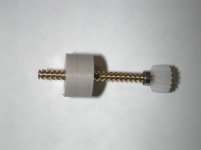implmex
Diamond
- Joined
- Jun 23, 2002
- Location
- Vancouver BC Canada
Hi All:
I've got another impossible part to quote, and I need advice on the repeatability of the rigid tapping process.
The thread is a double start ACME (actually the metric equivalent).
Major diameter: 3mm
Pitch: 1.5 mm
Lead 3.0 mm
Minor dia: 1.5 mm
Length: 5mm
Material: free machining brass (thank God!!)
Normally with a double start ACME internal thread I'd single point bore it, but this one is not possible to do that way because the minor diameter is so tiny.
Making an electrode and sinker EDM burning it with conventional orbiting is out too; the electrode cannot be made because if it's small enough to go in the hole, it won't have any center core to hold it together.
So I'm thinking of making a series of "two tooth" taps, ganged together side by side and of progressively larger size.
I can wire cut the teeth dead nuts accurately, so I'll know exactly where they are relative to one another both in X and in Z
My question is: if I just rigid tap with them one after the other, will the C axis on the lathe repeat accurately enough for them to progressively nibble out the thread without mis-indexing?
The rigid tap cycle is attractive because I can follow the spiral both into the part and back out.
What I obviously don't know is if the spindle always picks up the same index pulse when it co-ordinates the C and Z moves in a rigid tap cycle.
Normally you wouldn't need to care because with regular rigid tapping you only go into and back out of the part once with your tap unless you're peck tapping.
I want to go in and out a bunch of times, and always pick out the same helical path again, just with a different cutter each time.
So, those of you who know how the rigid tap cycle is controlled, your wisdom will be greatly appreciated.
The control is a Fanuc Oi Mate TC on a Prodigy gang chucker with C axis and rigid tap enabled.
Cheers
Marcus
Implant Mechanix ? Design & Innovation > HOME
Vancouver Wire EDM -- Wire EDM Machining
Clarus Microtech
I've got another impossible part to quote, and I need advice on the repeatability of the rigid tapping process.
The thread is a double start ACME (actually the metric equivalent).
Major diameter: 3mm
Pitch: 1.5 mm
Lead 3.0 mm
Minor dia: 1.5 mm
Length: 5mm
Material: free machining brass (thank God!!)
Normally with a double start ACME internal thread I'd single point bore it, but this one is not possible to do that way because the minor diameter is so tiny.
Making an electrode and sinker EDM burning it with conventional orbiting is out too; the electrode cannot be made because if it's small enough to go in the hole, it won't have any center core to hold it together.
So I'm thinking of making a series of "two tooth" taps, ganged together side by side and of progressively larger size.
I can wire cut the teeth dead nuts accurately, so I'll know exactly where they are relative to one another both in X and in Z
My question is: if I just rigid tap with them one after the other, will the C axis on the lathe repeat accurately enough for them to progressively nibble out the thread without mis-indexing?
The rigid tap cycle is attractive because I can follow the spiral both into the part and back out.
What I obviously don't know is if the spindle always picks up the same index pulse when it co-ordinates the C and Z moves in a rigid tap cycle.
Normally you wouldn't need to care because with regular rigid tapping you only go into and back out of the part once with your tap unless you're peck tapping.
I want to go in and out a bunch of times, and always pick out the same helical path again, just with a different cutter each time.
So, those of you who know how the rigid tap cycle is controlled, your wisdom will be greatly appreciated.
The control is a Fanuc Oi Mate TC on a Prodigy gang chucker with C axis and rigid tap enabled.
Cheers
Marcus
Implant Mechanix ? Design & Innovation > HOME
Vancouver Wire EDM -- Wire EDM Machining
Clarus Microtech




